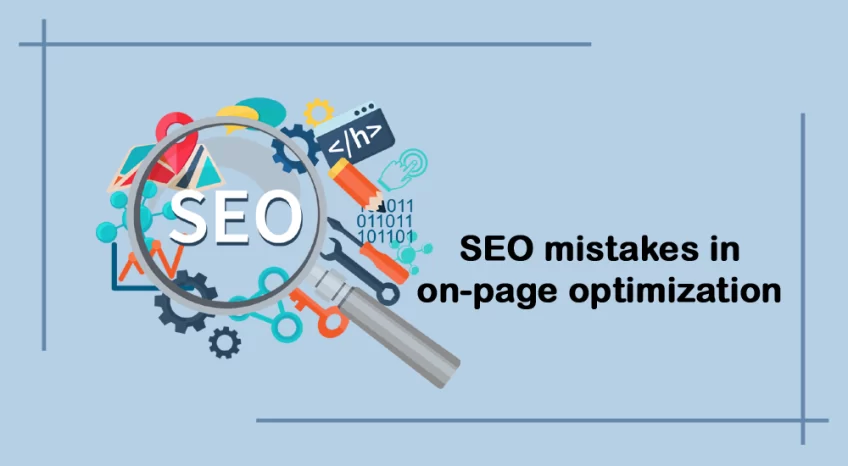What are the most common mistakes of on-page optimization? What must be avoided? How to make your site brilliant? Here is the guide!
On-page optimization: top mistakes to avoid
Search engine optimization (SEO) serves to make websites and shops better found by their target group. This makes it all the more annoying when all measures and optimizations seem to be of no use. What could be the reason? In most cases, it is small, unnecessary errors that do not cause the desired traffic to be missed.
It is not easy to keep track of all the SEO measures. Many factors only cause changes to a certain extent. Some also think that the more SEO – the better, and create “overoptimized” pages, which Google punishes with a loss of ranking. So that you can avoid the greatest sources of error, we have the list of the most common errors in the SEO on-page area for you here. Remember: no matter how brilliantly created your website is (websites built with Django are considered one of the best options nowadays), you must use neither too much SEO nor neglect it completely. So, let’s take a look at the top mistakes to avoid.
Content is king
The content is the heart of your website. A common mistake is that the home page contains either no or too little text – this can give the impression that you don’t have much to say and is also not user-friendly, as it forces the visitor to click unnecessarily on subpages to find out what your page is all about.
Your website should convey at first glance what its purpose is. The user should be able to find all the important information on the homepage and be made curious to then decide whether he wants to look further. The content should offer a clear, unique added value that you would like to read and distribute. (buy modafinil uk 2022 reddit) High-quality content increases the length of stay and, thus, ultimately ensures better search results.
Duplicate content
Another common error is duplicate content that people see on different URLs. So-called “duplicate content” can drag down the ranking results very drastically or, in the worst case, even filter them out, as Google believes that it is copied and, therefore, irrelevant content. Be sure to avoid it! Do not copy ready-made texts and rely on individuality.
Keywords in abundance
Quality over quantity! There is a difference between the targeted use of keywords and penetrating spamming. Suppose you repeat the irritating words at an unnaturally high frequency. In that case, this primarily interrupts the reader’s reading flow and is also punished with worse ranking results, as the search engines rate it as manipulation. It is perfectly sufficient if you mention your keywords once in the title tag and in the meta description.
Pile of h1 tags
Even with the headlines, it can sometimes be too much of a good thing. The hierarchy of your headings shows the search engines the structure of your website and where the focus is. Too many of them would be confusing and disorienting rather than helping the reader. Although you can generally set as many headlines as you want, at least the h1 tag should only appear once on each page. This contains your most important keywords and illustrates the overarching topic of the page. If you do not want to shorten your content accordingly, divide it and instead create more subpages.
No sitemap, no structure
A sitemap organizes your website’s navigation, including all subpages for the search engines. It’s like a table of contents that machines can read. This file can be created manually and uploaded to help search engines view your website. In addition, they are informed more quickly about changes (e.g., new subpages).
Incorrect links
Everyone knows and hates it: the error message 404. It means that a URL could not be retrieved – and thus was not indexed by the search engines. This happens, for example, when links refer to no longer existing targets. Error messages like these suggest a bad internal link to search engines and, conversely, cause a negative rating. Therefore, keep all your links up to date and check them regularly.
Other common errors in linking are, for example, different descriptions for the same link destination or if there are too many links on one page – this weakens their meaningfulness. Here, breadcrumb navigation can support, along with a lean website structure.
Missing metadata
The search engines use the metadata to generate a small preview of your website (so-called “snippets”). If these are missing, an alternative from the texts of your page will be automatically fabricated. However, it is usually more advantageous to determine the presence of the snippets by filling in the metadata.
The title must be about 70 characters long to be fully displayed in the search results. It should contain your most important keyword and only be used once to reinforce the meaning. The description, on the other hand, can be approximately one hundred sixty characters long without being cut off. It should also contain a relevant keyword and briefly summarize the page’s content.
Endless loading time
Nobody likes to have to wait a long time, not even on websites. You can significantly reduce your website’s loading times by avoiding uncompressed and code-scaled images. Rather compress the images in advance to reduce the file size and gain additional bytes.
Discarded or unfinished scripts unused in the backend of the website can also increase the loading time. Therefore, regularly update your platform and make it free of unused content.
No mobile optimization
Mobile web optimization is just as relevant today as desktop optimization (some say it is even more important. The trend toward mobile is constantly evolving, and there is no end in sight for the time being. That’s why it’s a pity that websites don’t offer users a mobile web version.
Non-mobile optimized websites can be recognized by far too small text, which is hardly readable, and buttons that are too close to each other. In addition, Flash content cannot be read by the smartphone, and this will cause error messages. These factors worsen the user experience instead of inviting the visitor to stay.
It’s time for error-free SEO!
Search engine optimization is a changing, long-lasting process that always brings new tasks and challenges. If one or more of these negative examples we have described apply to your website, you can now start eliminating these errors. Good luck!
Also Read: How to Get Organic Subscribers for Your YouTube Channel







